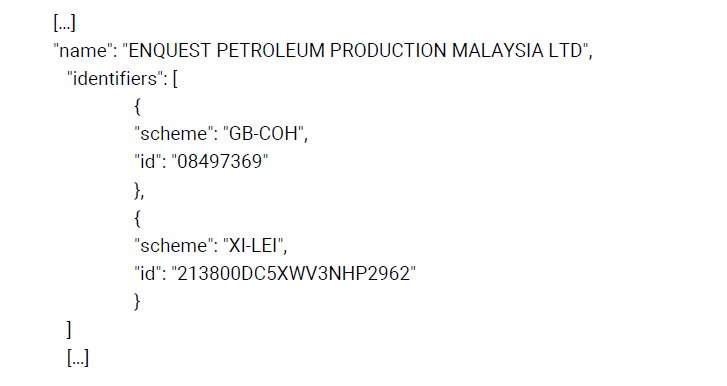Using reliable identifiers for corporate vehicles in beneficial ownership data
Multiple identifiers for entities
Entity identifiers are not only produced by jurisdictional registers. There are well-used international identifier schemes, such as the Legal Entity Identifier (LEI), [14] which produce reliable identifiers for corporate vehicles. There are also government agencies which produce their own identifiers for entities which can be reliably used; for example, a TIN is often a reliable entity identifier.
This leads to an issue which can undermine efforts to join different data sources by using common entity identifiers: the same entity may be represented in different datasets by different identifiers. For example, automatic joining of data on company name and company identifier would not pick up that these two records represent the same entity:
| Name | EQ PETROLEUM PRODUCTION MALAYSIA LTD | Name | ENQUEST PETROLEUM PRODUCTION MALAYSIA LTD |
| Identifier | GB-COH-08497369 | Identifier | XI-LEI- 213800DC5XWV3NHP2962 |
For this reason, when designing forms and data management systems for information disclosed about companies, it is important to require disclosure of all highly reliable identifiers. This way, all identifiers should be published as part of any data-sharing. In the above instance, even if one of the datasets had done so, the records could have been merged:
| Name | EQ PETROLEUM PRODUCTION MALAYSIA LTD | Name | ENQUEST PETROLEUM PRODUCTION MALAYSIA LTD |
| Identifier | GB-COH-08497369* | Identifier | XI-LEI- 213800DC5XWV3NHP2962 |
| Identifier | GB-COH-08497369* |
* Two records in different datasets clearly refer to the same entity
When collecting company information, as a minimum, an authoritative registration identifier as well as an LEI held by an entity (where it exists) should be disclosed. It may be appropriate to request a TIN as well, for example, if revenue and tax filings are to be brought together with the BO data. For completeness, disclosure of identifiers from proprietary schemes, such as Dun & Bradstreet’s DUNS numbers, may also be required. However, since such identifiers are not authoritative and they are not resolvable to those users of the data who do not have access to these proprietary schemes, they should not be relied upon as a primary identifier.
When sharing and exchanging BO data, Open Ownership’s Beneficial Ownership Data Standard [15] supports the use of multiple identifiers. The information above would be formatted in the following manner:

Where possible, agencies managing BO information should collect and publish multiple reliable identifiers for corporate vehicles.
Notes
[14] See: GLEIF (no date), “Introducing the Legal Entity Identifier (LEI)”. Retrieved from: https://www.gleif.org/en/about-lei/introducing-the-legal-entity-identifier-lei.
[15] See: Open Ownership (no date), Beneficial Ownership Data Standard (v0.3). Retrieved from: https://standard.openownership.org.